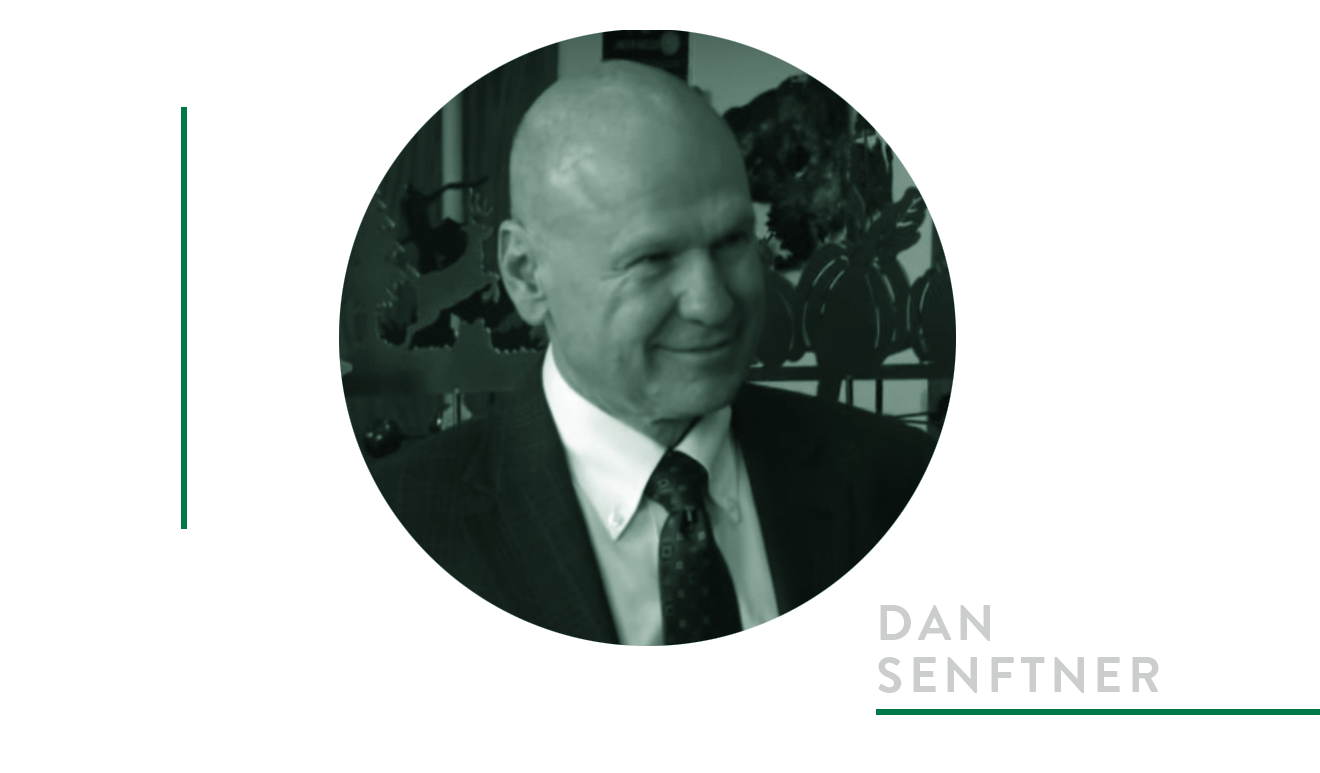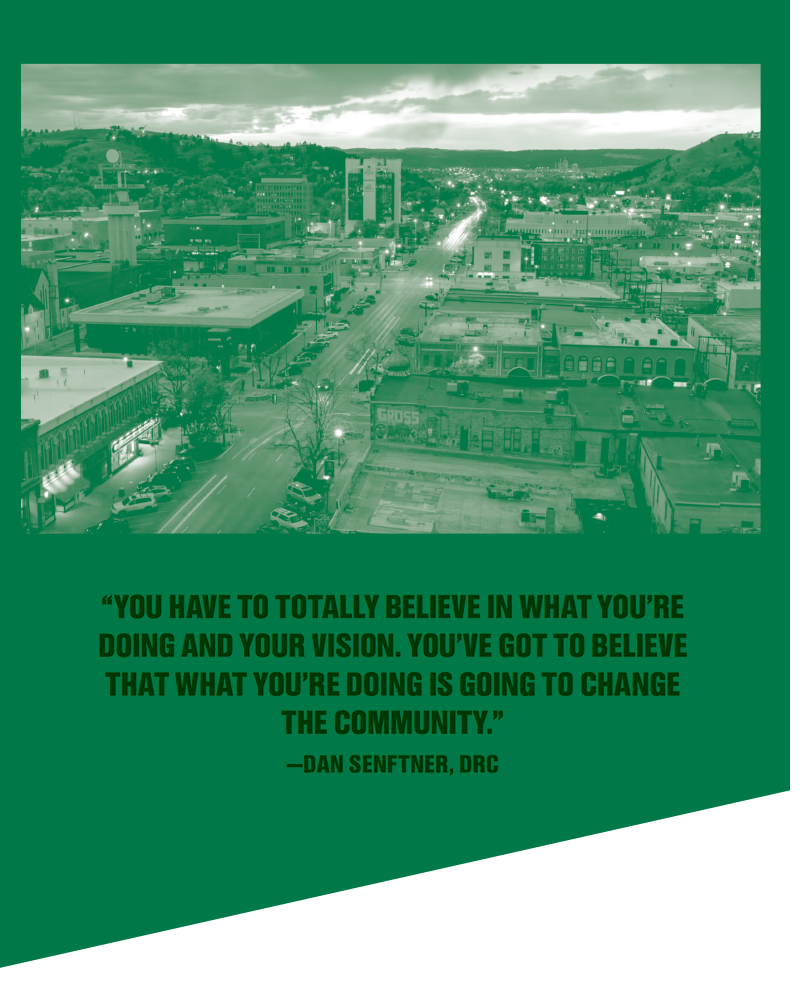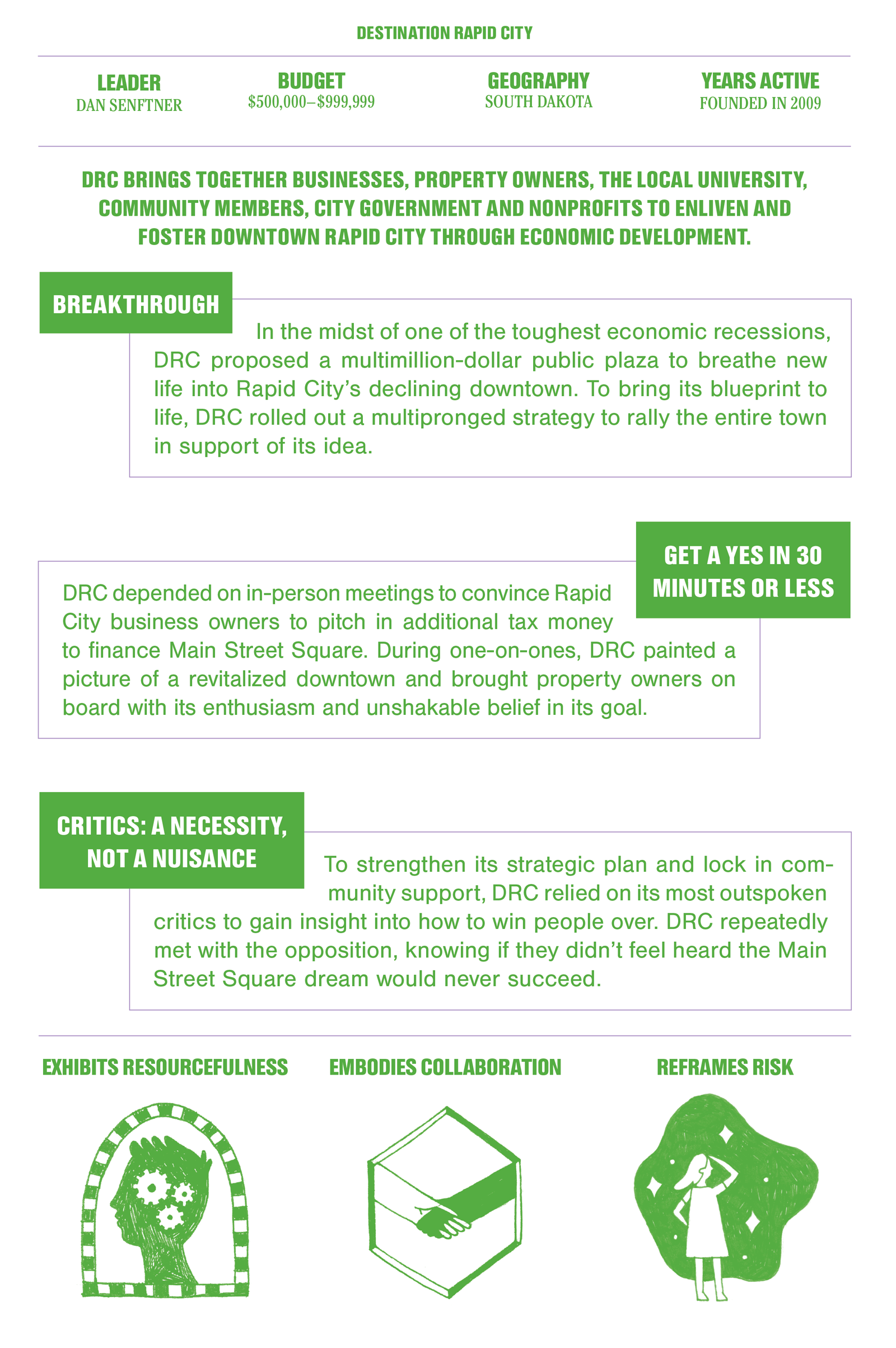
Dan Senftner saw three things in front of him: an aging city parking lot, a porn shop and a series of rundown buildings and empty storefronts. This stretch of Rapid City’s downtown didn’t look like much, but Dan knew it was destined for more. Where others saw asphalt, he envisioned a space that could transform the heart of downtown for decades to come.
In 2008, nearly one out of three downtown Rapid City businesses sat empty, and the local unemployment rate nearly doubled in a year. To keep the area from slipping further into decline, a network of philanthropists, property owners and entrepreneurs banded together to concoct an improbable plan: DRC proposed replacing the old parking lot with a downtown plaza to breathe life back into the central business district.
“It took something of a destination to make people want to come downtown,” says Dan, who took over as DRC’s president and CEO in 2010. “You’ve got to have that wow factor. That’s what gets people motivated.”

The plans for Main Street Square involved an ice-skating rink, a summertime fountain and a green space where community groups could host hundreds of events that would draw visitors to Rapid City’s historic core. The catch? DRC proposed its plan during one of the toughest recessions the city had ever seen. On top of that, DRC asked downtown property owners to form a business improvement district (BID) and tax themselves to cover part of the $6.5 million it would take to build the public space.
The square might seem like a ludicrous undertaking, especially in an economically conservative community like Rapid City, but Dan’s contagious excitement and DRC’s dedication to listening to the needs of local entrepreneurs and residents cemented community support. In a year, the group set up more than 100 appointments to share the plan for the new plaza with every business owner downtown.

After 18 months, DRC not only convinced more than half of the property owners in the central business district to support the creation of a new plaza, but it also persuaded a large part of the public, too. The city voted in favor of the project. In its fi rst year, Main Street Square brought 17,000 ice skaters to the plaza, nearly twice the amount it predicted. The BID transformed the downtown economy, in some cases doubling small business activity and lowering unoccupied storefronts from 30 percent to four percent. Twenty new businesses launched within a one-block radius of the square, including a $15 million remodel of a single property.
“Everyone wants to be involved in a success story, but it doesn’t start out that way in the beginning,” says Dan. “It doesn’t just happen by itself. It takes years and a lot of networking. You never want to leave a stone unturned. Do you know from day one it’s going to work? No. Do you do everything you can to prepare for it? Yes.”

GET A YES IN 30 MINUTES OR LESS
In thirty minutes or less, Dan often accomplished the unthinkable: convincing Rapid City business owners to pay an additional tax each year to help build a new, central gathering space.
It took Dan and another DRC volunteer nearly a year to meet with the 200 people affected by the proposed BID. When he did, he painted the picture of a transformed downtown—a revitalized space where arts and culture flourished, where small businesses thrived and where families gathered to spend time together.
“We need to make a change,” Dan told them. “Our town isn’t growing. We’re stagnant. We’ve got to stimulate our economy and that takes all of us working together. People will move past us if we don’t act.”

During those meetings, Dan sold downtown business owners on the future success story of Main Street Square. At the time, Dan had lived in Rapid City for more than four decades and had owned a business downtown for nearly 30 years. People in the community trusted him. At the end of each appointment, Dan pulled out a piece of paper and asked every owner if he or she would sign it in support of the BID. Nearly two-thirds agreed on the spot. For those who didn’t, Dan made sure to schedule a follow-up meet-ing before leaving the initial appointment so he would stay fresh in their minds.
“It’s important to get most of the community involved. Every possible chance I had to go see someone, I did,” says Dan.
“Your sponsors and your community start to gather and get behind you when they see the success of what you’re doing.”
Those in-person meetings tipped the scales in favor of DRC’s ambitious plan. For Dan, a phone call or an email simply couldn’t rival sitting down with people, shaking hands, looking them in the eye and explaining DRC’s vision. It would be hard for people to experience the enthusiasm and belief he had in Main Street Square through the lines of an email, but those sentiments weren’t easily missed when Dan sat across the table from business owners and city council members.
DRC’s strategy also included establishing an early base of support. To do that, Dan first met with the 10 largest businesses DRC thought would be most willing to support construction of Main Street Square. Then, Dan leveraged that top rung of individuals to encourage other downtown property owners to back DRC’s vision. Prior to these meetings, the organization also made sure to connect with Rapid City’s mayor and city council members to share its vision for the future.
By January 2010, two-thirds of all downtown property owners submitted a petition to the city in favor of forming the district. By April, the city council unanimously voted to approve the BID, but DRC’s fight to reimagine Rapid City didn’t stop there.

CRITICS: A NECESSITY, NOT A NUISANCE
Just when DRC thought it was in the clear to move forward with plans for Main Street Square, a group of downtown business owners halted progress. Opponents collected enough signatures to bypass the unanimous city council vote and defer the BID to a citywide public vote before construction could begin.

Dan met the man for lunch, stopped by his business and even brought him to DRC’s office. Before long, Main Street Square’s biggest opponent not only got on board with the plan, but even started volunteering for the project.
“They will listen to you if you stop and listen to them. They’ve got to be heard,” says Dan. “If they aren’t, you lose for sure.”
Opposition strengthened DRC’s vision. Criticism showed DRC where it needed to flesh out its plan, or what questions it needed to know how to answer better. Listening became both an offensive and a defensive strategy for DRC. The more the organization took notice of complaints from critics, the more those individuals opened up to hearing about the vision DRC wanted to bring to life in downtown Rapid City. Each side got to know the other’s needs and wants better. One-on-one meetings also clued staff into the issues opponents planned to raise at public meetings before representatives ever got up to speak in front of the public. Hearing that feedback ahead of time allowed DRC to tweak its plan and presentation to address those concerns before holding city-wide meetings.
After 18 months, the city council unanimously approved DRC’s blueprint for a second time after 55 percent of the public voted to approve the business improvement district. DRC built the plaza and opened it to the public in 2011. Main Street Square officials projected the square would have a $1.7 million impact on the downtown area. In its first year, the ice rink sold 17,000 day passes. When the plaza closed its books at the end of 2011, it showed a $35,514 revenue surplus. Thanks to its success, DRC with-drew its request for $100,000 from the city in 2012 and declared it would not seek city funds in 2013.
Other than ice skating, Main Street Square doesn’t charge for most of the 200 events it hosts every year. Concert series, broomball tournaments and events like a one-day pumpkin festival draw 600,000 to 700,000 visitors a year from Rapid City and the city’s surrounding Native nations, schools and military base. DRC continues to use community input to vet ideas for future projects and events, like a crosswalk residents asked DRC to develop that would connect the downtown area to the civic center.
Main Street Square became the success story DRC originally painted for Rapid City business owners and res-idents. The organization took a blighted area of town and transformed it from tumbleweeds and rundown buildings to a grand city square. Today, it’s the symbol of the vibrant future that encourages new people to call Rapid City home.




Produced in partnership with the Bush Foundation
to showcase the culture of innovation
behind its Bush Prize winners.
Contributors




